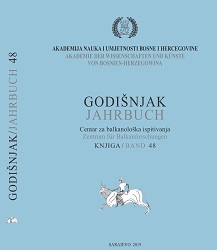Zepteräxte der Bronzezeit in Osteuropa
Bronze Age scepter axes in Eastern Europe
Author(s): Eugen Sava, Elke Kaiser, Mariana SîrbuSubject(s): Archaeology, Social history, Ancient World
Published by: Akademija Nauka i Umjetnosti Bosne i Hercegovine
Keywords: Stone axes; Scepters; Bronze Age; Status symbols; Insignia of power; Hoard;
Summary/Abstract: In this article, the theme of the stone axes in the Borodino hoard is taken up again in view of a newly discovered polished axe, probably made of diorite. The axe was handed over to the National Museum of History of Republic Moldova in Chişinău in 2019. Other such polished axes are known from the Prut-Dniester area, which are published here in high-quality photographs. The aforementioned Borodino assemblage was found in 1912, not far from the present state border between the Republic of Moldova and Ukraine, contained metal objects and also semi-precious stone axes and mace heads. , Although mostly little is known about their find circumstances, these finds from the Prut-Dniester area nevertheless increase the number of comparisons for the axes of the Borodino type and also show that such axe forms were not unique in the Bronze Age of the northwestern Black Sea region. Many of the analogies for the Borodino type axes date to the late Middle Bronze Age and the Late Bronze Age (Post-Catacomb and Srubnaya cultures). The article discusses traditions in the production and use of such elaborate stone axes in Eastern Europe and contemplates the possibility that the finely worked axes and mace heads can be interpreted as having originally served as sceptres.
Journal: Godišnjak Centra za balkanološka ispitivanja
- Issue Year: 2019
- Issue No: 48
- Page Range: 125-136
- Page Count: 12
- Language: German

